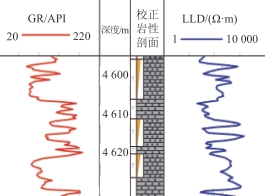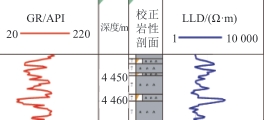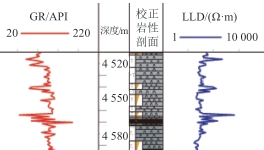

Oil & Gas Geology ›› 2024, Vol. 45 ›› Issue (3): 801-815.doi: 10.11743/ogg20240316
• Petroleum Geology • Previous Articles Next Articles
Ning LI1,2( ), Ruilei LI2, He MIAO2, Kaifang CAO2, Jun TIAN2
), Ruilei LI2, He MIAO2, Kaifang CAO2, Jun TIAN2
Received:2024-01-12
Revised:2024-05-20
Online:2024-07-01
Published:2024-07-01
CLC Number:
Ning LI, Ruilei LI, He MIAO, Kaifang CAO, Jun TIAN. Stepwise identification of favorable facies belts and reservoir sweet spots of deep intermediate-basic volcanic rocks in the Songliao Basin[J]. Oil & Gas Geology, 2024, 45(3): 801-815.
Add to citation manager EndNote|Reference Manager|ProCite|BibTeX|RefWorks
Table 1
Logging curve characteristics of volcanic facies in the Huoshiling Formation, Chaganhua area"
| 岩相 | 亚相 | 测井相 | 典型测井曲线特征 | 岩性特征 |
|---|---|---|---|---|
| 爆发相(水下) | 气携水下热碎屑流亚相 |  | 低GR,高LLD,曲线形态为微齿,常与水携火山密度流亚相伴生产出 | 浅灰色、灰色凝灰岩,局部含火山角砾,发育粒序层理 |
| 水携火山密度流亚相 | 中-高GR,中-高LLD,曲线形态为高幅指形,常与热碎屑流亚相互层产出 | 灰色、深灰色凝灰岩,夹薄层沉凝灰岩条带,发育层理构造 | ||
| 火山沉积相 | 含外碎屑火山沉积亚相 |  | 中-低GR,低LLD(<40 Ω·m),曲线形态为中幅指形 | 深灰色-灰黑色凝灰质砂岩、凝灰质泥岩,局部,块状构造,内部结构较均一 |
| 再搬运火山碎屑沉积 |  | 中-高GR,低LLD(<40 Ω·m)特征,曲线形态为微齿-近平滑形态,局部夹薄层爆发相 | 深灰色-灰黑色沉凝灰岩,粒度细,块状构造,内部结构较均一 | |
| 溢流相 | 上部 |  | 低GR,中LLD特征,曲线形态为低幅指化 | 气孔玄武岩、安山岩,常呈薄层产出 |
| 下部 | 低GR,中LLD特征,曲线形态为箱形 | 玄武岩、安山岩,岩性均一,与顶底围岩突变接触 |
| 1 | 李瑞磊, 杨立英, 朱建峰, 等. 松辽盆地南部断陷层火山岩储层特征及油气成藏主控因素[J]. 地学前缘, 2023, 30(4): 100-111. |
| LI Ruilei, YANG Liying, ZHU Jianfeng, et al. Volcanic reservoir characteristics and hydrocarbon accumulation control factors of rift depressions in southern Songliao Basin[J]. Earth Science Frontiers, 2023, 30(4): 100-111. | |
| 2 | 衣健, 王璞珺, 李瑞磊, 等. 松辽盆地断陷层系地震火山地层学研究: 典型火山岩地震相与地质解释模式[J]. 吉林大学学报(地球科学版), 2014, 44(3): 715-729. |
| YI Jian, WANG Pujun, LI Ruilei, et al. Seismic volcanostratigraphy of the Songliao Basin, Early Cretaceous: Typical volcanic seismic facies and geological interpretation pattern[J]. Journal of Jilin University(Earth Science Edition), 2014, 44(3): 715-729. | |
| 3 | 郭飞, 李黎, 董政, 等. 海上少井条件下低渗薄礁滩灰岩储层甜点定量解释——以珠江口盆地A油田为例[J]. 石油地球物理勘探, 2023, 58(2): 381-391. |
| GUO Fei, LI Li, DONG Zheng, et al. Quantitative interpretation of sweet spots in low-permeability limestone reservoirs in thin reef beach with few offshore wells: A case study of A oilfield in Pearl River Mouth Basin[J]. Oil Geophysical Prospecting, 2023, 58(2): 381-391. | |
| 4 | 刘玲, 王琳霖, 吴疆, 等. 鄂尔多斯盆地南部彬长区块上石盒子组7段储层识别与预测[J]. 石油与天然气地质, 2021, 42(5): 1124-1135. |
| LIU Ling, WANG Linlin, WU Jiang, et al. Reservoir identification and prediction of He 7 member in Binchang Block, southern Ordos Basin[J]. Oil & Gas Geology, 2021, 42(5): 1124-1135. | |
| 5 | 李国斌, 张亚军, 谢天峰, 等. 煤系地层致密砂岩气甜点区地震逐级预测——以鄂尔多斯盆地东南缘下二叠统山西组23亚段为例[J]. 天然气工业, 2020, 40(5): 34-42. |
| LI Guobin, ZHANG Yajun, XIE Tianfeng, et al. Seismic stepped prediction technology for tight sandstone gas sweet spot in coal measure strata: A case study of the submember 23 of the Lower Permian Shanxi Formation along the southeastern margin of the Ordos Basin[J]. Natural Gas Industry, 2020, 40(5): 34-42. | |
| 6 | 刘小平, 杨晓兰, 曾忠玉, 等. 多参数联合反演在火成岩储集体预测中的应用[J]. 石油地球物理勘探, 2007, 42(1): 44-49. |
| LIU Xiaoping, YANG Xiaolan, ZENG Zhongyu, et al. Application of multi-parameter joint inversion in prediction of igneous reservoir[J]. Oil Geophysical Prospecting, 2007, 42(1): 44-49. | |
| 7 | 郎晓玲, 韩龙, 王世瑞, 等. XB地区火山岩岩相划分及储层精细刻画[J]. 石油地球物理勘探, 2010, 45(2): 272-277. |
| LANG Xiaoling, HAN Long, WANG Shirui, et al. Lithofacies classification and reservoir delineation for volcanic rock in XB area[J]. Oil Geophysical Prospecting, 2010, 45(2): 272-277. | |
| 8 | 王玲, 张研, 戴晓峰, 等. 徐深气田徐深9井区火山岩气藏有效储层识别方法[J]. 石油地球物理勘探, 2010, 45(5): 741-747, 767. |
| WANG Ling, ZHANG Yan, DAI Xiaofeng, et al. Identification of effective volcanic gas reservoir in the block of Xushen-9 Well, Xushen Gas Field[J]. Oil Geophysical Prospecting, 2010, 45(5): 741-747, 767. | |
| 9 | 李忠诚. 火山岩储层变参数门槛值体控联合反演新方法[J]. 特种油气藏, 2015, 22(3): 55-57. |
| LI Zhongcheng. New approach of joint inversion of data volume control by threshold value of variant parameters in volcanic rock reservoir[J]. Special Oil & Gas Reservoirs, 2015, 22(3): 55-57. | |
| 10 | 仇鹏, 孔丽娜, 李道清, 等. 基于体控建模的内幕型火山岩气藏有效储层预测——以准噶尔盆地五彩湾凹陷火山岩气藏为例[J]. 天然气工业, 2017, 37(3): 48-55. |
| QIU Peng, KONG Lina, LI Daoqing, et al. Prediction of net pay zones in volcanic reservoirs with inner structures based on rock-mass controlled modeling: A case study of volcanic gas reservoirs in the Wucaiwan sag, Junggar Basin[J]. Natural Gas Industry, 2017, 37(3): 48-55. | |
| 11 | 单玄龙, 牟汉生, 刘玉虎, 等. 湖盆水下喷发火山岩相类型、特征与储集意义——以松辽盆地南部查干花地区白垩系为例[J]. 石油勘探与开发, 2023, 50(4): 719-730. |
| SHAN Xuanlong, MU Hansheng, LIU Yuhu, et al. Subaqueous volcanic eruptive facies, facies model and its reservoir significance in a continental lacustrine basin: A case from the Cretaceous in Chaganhua area of southern Songliao Basin, NE China[J]. Petroleum Exploration and Development, 2023, 50(4): 719-730. | |
| 12 | 王璞珺, 吴河勇, 庞颜明, 等. 松辽盆地火山岩相: 相序、相模式与储层物性的定量关系[J]. 吉林大学学报(地球科学版), 2006, 36(5): 805-812. |
| WANG Pujun, WU Heyong, PANG Yanming, et al. Volcanic facies of the Songliao Basin: Sequence, model and the quantitative relationship with porosity & permeability of the volcanic reservoir[J]. Journal of Jilin University(Earth Science Edition), 2006, 36(5): 805-812. | |
| 13 | 陈树民, 姜传金, 张元高, 等. 盆内火山岩反射地震响应及对油气藏分布的多尺度预测[J]. 大庆石油地质与开发, 2014, 33(5): 190-198. |
| CHEN Shumin, JIANG Chuanjin, ZHANG Yuangao, et al. Seismic response to intrabasinal volcanic rock reflection and multi-scale prediction of hydrocarbon reservoir distribution[J]. Petroleum Geology & Oilfield Development in Daqing, 2014, 33(5): 190-198. | |
| 14 | 唐华风, 边伟华, 王璞珺, 等. 盆地火山岩相分类和模式[J]. 吉林大学学报(地球科学版), 2023, 53(06): 1651-1671. |
| TANG Huafeng, BIAN Weihua, WANG Pujun, et al. Classification and model of volcanic facies in the basin. Journal of Jilin University (Earth Science Edition), 2023, 53(6): 1651-1671. | |
| 15 | 张姣, 辛朝坤, 张军勇. 火山喷发机构、期次及其控藏作用——以松辽盆地北部莺山凹陷营一段为例[J]. 石油与天然气地质, 2018, 39(2): 291-299. |
| ZHANG Jiao, XIN Chaokun, ZHANG Junyong. A study on volcanic eruption edifices and stages and their control over hydrocarbon accumulation: A case study of the first member of the Yingcheng Formation in Yingshan Sag, northern Songliao Basin[J]. Oil & Gas Geology, 2018, 39(2): 291-299. | |
| 16 | 于孝玉, 阮宝涛, 王志文, 等. 火山岩气藏火山口多信息识别技术及应用[J]. 物探化探计算技术, 2011, 33(4): 351-357. |
| YU Xiaoyu, RUAN Baotao, WANG Zhiwen, et al. Multi-information identification technique of crater and its application to volcanic gas reservoirs[J]. Computing Techniques for Geophysical and Geochemical Exploration, 2011, 33(4): 351-357. | |
| 17 | 鲁银涛, 王彬, 吕福亮, 等. 南海西北部火山岩地震属性特征及发育模式[J]. 地球物理学进展, 2014, 29(5): 2407-2410. |
| LU Yintao, WANG Bin, Fuliang LYU, et al. Seismic attributes and evolutional models of volcanic rocks in northwest part of South China Sea[J]. Progress in Geophysics, 2014, 29(5): 2407-2410. | |
| 18 | 刘学通, 周学锋, 刘传奇, 等. 中心式火山通道边界精细识别技术研究——以渤海A油田为例[J]. 地球物理学进展, 2019, 34(1): 342-346. |
| LIU Xuetong, ZHOU Xuefeng, LIU Chuanqi, et al. Accurate boundary recognition research of central volcanic conduit: An example from Bohai A oilfield[J]. Progress in Geophysics, 2019, 34(1): 342-346. | |
| 19 | 何贤英, 刘勇, 许学龙, 等. 西泉地区石炭系火山岩储层主控因素及有利储层预测[J]. 岩性油气藏, 2017, 29(3): 42-51. |
| HE Xianying, LIU Yong, XU Xuelong, et al. Controlling factors of Carboniferous volcanic reservoirs and favorable reservoir prediction in Xiquan area, Junggar Basin[J]. Lithologic Reservoirs, 2017, 29(3): 42-51. | |
| 20 | 曹磊, 蔡峰. 基于地震属性融合技术的火山通道识别研究[J]. 地球物理学进展, 2021, 36(2): 559-564. |
| CAO Lei, CAI Feng. Recognition research of volcanic conduit based on seismic attribute fusion technology[J]. Progress in Geophysics, 2021, 36(2): 559-564. | |
| 21 | 王璞珺, 迟元林, 刘万洙, 等. 松辽盆地火山岩相: 类型、特征和储层意义[J]. 吉林大学学报(地球科学版), 2003, 33(4): 449-456. |
| WANG Pujun, CHI Yuanlin, LIU Wanzhu, et al. Volcanic facies of the Songliao Basin: Classification, characteristics and reservoir significance[J]. Journal of Jilin University(Earth Science Edition), 2003, 33(4): 449-456. | |
| 22 | 舒萍, 丁日新, 曲延明, 等. 徐深气田火山岩储层岩性岩相模式[J]. 天然气工业, 2007, 27(8): 23-27. |
| SHU Ping, DING Rixin, QU Yanming, et al. Lithologic and lithofacies patterns of volcanic reservoirs in Xushen Gas Field[J]. Natural Gas Industry, 2007, 27(8): 23-27. | |
| 23 | 孙圆辉, 宋新民, 冉启全, 等. 长岭气田火山岩岩性和岩相特征及其对储集层的控制[J]. 石油勘探与开发, 2009, 36(1): 68-73. |
| SUN Yuanhui, SONG Xinmin, RAN Qiquan, et al. Lithologic and lithofacies characteristics of volcanic rock and their control over reservoirs, Changling Gasfield[J]. Petroleum Exploration and Development, 2009, 36(1): 68-73. | |
| 24 | 赵耀, 潘虹, 骆飞飞, 等. 准噶尔盆地红车断裂带石炭系火山岩储层特征及质量控制因素[J]. 石油与天然气地质, 2023, 44(5): 1129-1140. |
| ZHAO Yao, PAN Hong, LUO Feifei, et al. Characteristics and quality determinants of Carboniferous volcanic reservoirs in the Hongche fault zone, Junggar Basin[J]. Oil & Gas Geology, 2023, 44(5): 1129-1140. | |
| 25 | 曹鉴华, 姜传金, 赵福海, 等. 松辽盆地北部徐家围子断陷丰乐地区深层营城组有利火山岩储集体预测[J]. 石油与天然气地质, 2012, 33(4): 520-525. |
| CAO Jianhua, JIANG Chuanjin, ZHAO Fuhai, et al. Volcanic reservoir prediction of Yingcheng Formation in Fengle area, Xujiaweizi fault depression, northern Songliao Basin[J]. Oil & Gas Geology, 2012, 33(4): 520-525. | |
| 26 | 王岩泉, 胡大千, 蔡国刚, 等. 辽河盆地东部凹陷火山岩储层特征与主控因素[J]. 石油学报, 2013, 34(5): 896-904. |
| WANG Yanquan, HU Daqian, CAI Guogang, et al. Characteristics and controlling factors of Cenozoic volcanic reservoirs in Liaohe Basin, NE China[J]. Acta Petrolei Sinica, 2013, 34(5): 896-904. | |
| 27 | 徐敏, 梁虹, 邓绍强, 等. 四川盆地二叠系火山岩地震响应 特征及分布规律[J]. 科学技术与工程, 2019, 19(29): 27-32. |
| XU Min, LIANG Hong, DENG Shaoqiang, et al. Seismic response characteristics and distribution of Permian volcanic rocks in Sichuan basin[J]. Science Technology and Engineering, 2019, 19(29): 27-32. | |
| 28 | 唐华风, 王璞珺, 姜传金, 等. 松辽盆地白垩系营城组隐伏火山机构物理模型和地震识别[J]. 地球物理学进展, 2007, 22(2): 530-536. |
| TANG Huafeng, WANG Pujun, JIANG Chuanjin, et al. Physical model and seismic recognition of concealed volcanic edifices of Yingcheng Formation in Songliao Basin, Cretaceous, NE China[J]. Progress in Geophysics, 2007, 22(2): 530-536. | |
| 29 | 唐华风, 胡佳, 李建华, 等. 松辽盆地断陷期火山岩典型地震相的地质解译[J]. 石油地球物理勘探, 2018, 53(5): 1075-1084. |
| TANG Huafeng, HU Jia, LI Jianhua, et al. Geological significances of typical seismic facies of volcanic rocks of the rifted period in Songliao Basin, NE China[J]. Oil Geophysical Prospecting, 2018, 53(5): 1075-1084. | |
| 30 | 于宝利, 刘新利, 范素芳, 等. 火山岩相地震研究方法及应用[J]. 新疆石油地质, 2009, 30(2): 264-266. |
| YU Baoli, LIU Xinli, FAN Sufang, et al. Seismic technique and application of volcanic rock facies[J]. Xinjiang Petroleum Geology, 2009, 30(2): 264-266. | |
| 31 | 李希元, 景田, 吴昊. 火山岩的地震波场特征及其岩相的识别方法[J]. 大庆石油地质与开发, 2016, 35(2): 121-126. |
| LI Xiyuan, JING Tian, WU Hao. Identifying method of the seismic wave field characteristics and their lithofacieses for the volcanic rocks[J]. Petroleum Geology & Oilfield Development in Daqing, 2016, 35(2): 121-126. | |
| 32 | 陈骁, 何青林, 冉崎, 等. 四川盆地二叠系火山岩地震相特征及识别[J]. 天然气工业, 2019, 39(2): 28-36. |
| CHEN Xiao, HE Qinglin, RAN Qi, et al. Features and recognition for seismic facies of Permian volcanic reservoirs in the Sichuan Basin[J]. Natural Gas Industry, 2019, 39(2): 28-36. | |
| 33 | 张营革. 能量半衰时属性在浊积岩储层预测中的应用研究[J]. 石油物探, 2013, 52(6): 662-668. |
| ZHANG Yingge. The application of energy half-time attribute to turbidite reservoir prediction[J]. Geophysical Prospecting for Petroleum, 2013, 52(6): 662-668. | |
| 34 | 郭迎春, 张军华, 刘磊, 等. 能量半时地震属性的诠释与应用[J]. 地球物理学进展, 2015, 30(2): 746-751. |
| GUO Yingchun, ZHANG Junhua, LIU Lei, et al. The annotation and application of energy half-time attribute[J]. Progress in Geophysics, 2015, 30(2): 746-751. |
| [1] | Bo LIU, Qi’an MENG, Xiaofei FU, Tiefeng LIN, Yunfeng BAI, Shansi TIAN, Jinyou ZHANG, Yao YAO, Xinyang CHENG, Zhao LIU. Composition of generated and expelled hydrocarbons and phase evolution of shale oil in the 1st member of Qingshankou Formation, Songliao Basin [J]. Oil & Gas Geology, 2024, 45(2): 406-419. |
| [2] | Longde SUN, Xiaojun WANG, Zihui FENG, Hongmei SHAO, Huasen ZENG, Bo GAO, Hang JIANG. Formation mechanisms of nano-scale pores/fissures and shale oil enrichment characteristics for Gulong shale, Songliao Basin [J]. Oil & Gas Geology, 2023, 44(6): 1350-1365. |
| [3] | Zongquan HU, Ruyue WANG, Jing LU, Dongjun FENG, Yuejiao LIU, Baojian SHEN, Zhongbao LIU, Guanping WANG, Jianhua HE. Storage characteristic comparison of pores between lacustrine shales and their interbeds and differential evolutionary patterns [J]. Oil & Gas Geology, 2023, 44(6): 1393-1404. |
| [4] | He LIU, Siwei MENG, Suling WANG, Kangxing DONG, Liu YANG, Jiaping TAO, Lihao LIANG. Mechanical characteristics and fracture propagation mechanisms of the Gulong shale [J]. Oil & Gas Geology, 2023, 44(4): 820-828. |
| [5] | Bin BAI, Chaocheng DAI, Xiulin HOU, Liang YANG, Rui WANG, Lan WANG, Siwei Meng, Ruojing DONG, Yuxi LIU. Geological heterogeneity of shale sequence and evaluation of shale oil sweet spots in the Qingshankou Formation, Songliao Basin [J]. Oil & Gas Geology, 2023, 44(4): 846-856. |
| [6] | Dan LYU, Huajian WANG, Gang LI, Jiangyong ZHANG, Xiuli FU, Chang LIU, Xiaomei WANG, Rukai ZHU, Shuichang ZHANG. Paleobiological evidence of the paleowater environment evolution during deposition of the Qingshankou shale in the Songliao Basin [J]. Oil & Gas Geology, 2023, 44(4): 857-868. |
| [7] | Tianshu ZHANG, Rukai ZHU, Yi CAI, Huajian WANG, Dan LYU, Haiyan ZHOU, Xiuli FU, Chang LIU, Kunning CUI, Surong ZHANG, Bo WANG, Songtao WU, Jingya ZHANG, Xiaohua JIANG, Youliang FENG, He LIU. Distribution of organic matter in the Qingshankou Formation Shale, Gulong Sag, Songliao Basin observed within an isochronous sequence stratigraphic framework [J]. Oil & Gas Geology, 2023, 44(4): 869-886. |
| [8] | Zhongcheng Li, Zhidong Bao, Zhaodheng Wei, Guoyi Zhang, Yanqqing Shi, Mingyi Hu, Qingjie Deng. Sequence stratigraphy and sedimentary filling characteristics of a half-graben rift lake basin during the initial rifting period: A case study of the 2nd member of Lower Cretaceous Huoshiling Formation, Linan Sag, Songliao Basin [J]. Oil & Gas Geology, 2022, 43(3): 670-681. |
| [9] | Weitao Wu, Jingzhou Zhao, Qi'an Meng, Tiefeng Lin, Ge Zhang, Jinyou Zhang, Shanghua Si, Yubin Bai. Accumulation mechanism of tight sandstone oil in Gaotaizi reservoir in Qijia area, Songliao Basin [J]. Oil & Gas Geology, 2021, 42(6): 1376-1388. |
| [10] | Longhui Bai, Bo Liu, Yaao Chi, Shichao Li, Xun Wen. 2D NMR studies of fluids in organic-rich shale from the Qingshankou Formation, Songliao Basin [J]. Oil & Gas Geology, 2021, 42(6): 1389-1400. |
| [11] | Zhiqiang Feng, Li Dong, Ying Tong, Zihui Feng, Shun Zhang, Gaokui Wu, Qiang Ren. Impacts of the closure of eastern Mongolia-Okhotsk Ocean on formation and evolution of Songliao Basin [J]. Oil & Gas Geology, 2021, 42(2): 251-264. |
| [12] | Fancheng Zeng, Changmin Zhang, Zhongcheng Li, Guoyi Zhang, Chi Zhang, Yongjun Wang, Wentie Sun, Qingjie Deng. Controlling factors and distribution pattern of effective tight gas pools in blocky pyroclastic rocks in the Cretaceous Shahezi Formation in Wangfu gas field, southern Songliao Basin [J]. Oil & Gas Geology, 2021, 42(2): 481-493. |
| [13] | Gao Shuai, Gong Lei, Liu Xiaobo, Liu Bo, Gao Ang, Su Xiaocen, Wang Jie, Li Jing. Distribution and controlling factors of natural fractures in deep tight volcanic gas reservoirs in Xujiaweizi area,Northern Songliao Basin [J]. Oil & Gas Geology, 2020, 41(3): 503-512. |
| [14] | Deng Qingjie, Kang Dejiang, Hu Mingyi, Shen Jiao, Lei Ming. Architecture of channel reservoirs of shallow-water delta in the 4th member of Cretaceous Quantou Formation in southern Sanzhao Sag,Songliao Basin [J]. Oil & Gas Geology, 2020, 41(3): 513-524. |
| [15] | Xiaohan Mei, Qin Zhang, Yayun Wang, Xinsong Wu, Jingyan Liu, Jiahong Zhao, Wuxue Wang. Hydrochemical characteristics of formation water and its relationship with hydrocarbon migration and accumulation in Fuyang oil layer in Fuxin Uplift, Songliao Basin [J]. Oil & Gas Geology, 2020, 41(2): 328-338, 358. |
| Viewed | ||||||
|
Full text |
|
|||||
|
Abstract |
|
|||||